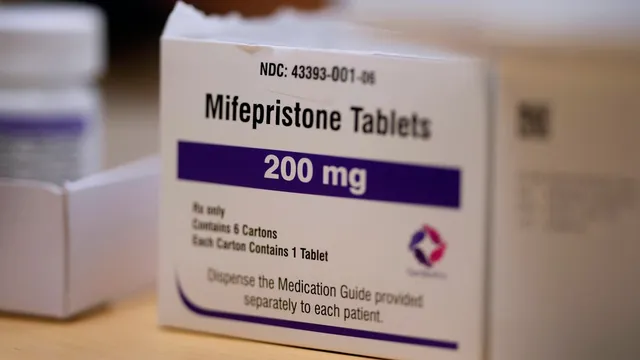
FDA commissioner reviews safety of abortion drug mifepristone amid concerns
2025-06-04 15:39- Marty Makary, FDA Commissioner, announced a review of mifepristone safety after a concerning study.
- The study indicated that 11% of women experienced severe side effects, substantially higher than current labeling.
- The review may lead to potential changes in regulations regarding medical abortion drugs.
Express your sentiment!
Insights
In the United States, on June 4, 2025, Food and Drug Administration Commissioner Marty Makary announced plans to review the safety of mifepristone, an abortion drug, following a recent study that reported alarming medical side effects. The study, conducted by the Ethics and Public Policy Center, indicated that 11% of women who used mifepristone experienced severe issues such as sepsis, infection, or hemorrhaging within 45 days post-administration. This figure was notably higher than what is currently stated on the drug's official label, as it was reported to be 22 times greater. U.S. Senator Josh Hawley, a Republican from Missouri, initially brought this study to Makary’s attention. In his communication with the FDA commissioner, Hawley expressed his concerns regarding the significant discrepancy between the actual side effects reported in the study and those identified on the mifepristone label. He urged the FDA to reinstate safety regulations for the drug immediately, implying that the existing guidelines might not sufficiently protect women who opt for medical abortions. The urgency communicated by Hawley highlights ongoing debates over reproductive health regulations and the importance of stringent oversight by the FDA. Makary, during his Senate confirmation hearing earlier in 2025, previously indicated he would oversee a review of mifepristone but had not taken action until informed about the study by Hawley. His commitment, as stated in his letter to Hawley, includes collaboration with the FDA's professional career scientists to ensure a thorough examination of the data concerning mifepristone’s safety profile. When addressing the senators, Makary mentioned that the agency is committed to consistently monitoring the post-marketing safety data associated with mifepristone, emphasizing the FDA's responsibility in safeguarding public health. The backdrop of this issue also includes a larger narrative concerning abortion access in the United States. Earlier in 2025, the Biden administration had introduced policies that permitted women to obtain abortion drugs without requiring in-person medical appointments, which some critics argue may pose safety risks. As a result, this review led by Makary may set precedent for future regulations regarding medical abortion and safety, particularly in a polarized political landscape where views on abortion rights are deeply divided. Moreover, in response to this study and the ensuing conversation, it is likely that the review will spark renewed discussions among policymakers and healthcare professionals about the safety and regulation of medical abortion drugs like mifepristone.
Contexts
The FDA regulations on mifepristone, a medication used for medical abortion, address not only the drug's approval process but also the monitoring of its side effects to ensure patient safety. Mifepristone was approved by the FDA in 2000 under a risk evaluation and mitigation strategy (REMS) due to concerns about its potential side effects and serious complications that may arise from its use. The FDA requires specific guidelines and protocols for prescribers and patients, including extensive discussions about possible adverse outcomes. These regulations aim to mitigate risks associated with the drug while providing access to it for those who choose to terminate a pregnancy medically. Among the known side effects of mifepristone are heavy bleeding, cramping, nausea, and vomiting, which are usually self-limiting. However, more serious complications, such as infection, retained products of conception, and rupture of the uterus, can occur, although they are relatively rare. The FDA has placed an emphasis on the need for proper follow-up to monitor the patient's condition after administering mifepristone, including follow-up appointments to ensure that the abortion is complete and that the patient is not experiencing severe side effects. These measures are part of an ongoing effort to balance the accessibility of abortion services with the necessity to protect women's health. In recent years, there has been growing scrutiny and debate surrounding the FDA's regulations on mifepristone, particularly concerning its REMS designation. Advocates for reproductive health argue that these regulations may create barriers for women seeking access to mifepristone, urging the FDA to consider whether the restrictions are still necessary given substantial data on the safety of the drug when prescribed properly. Current research and studies suggest that mifepristone has a good safety profile, particularly when compared to surgical abortion methods and other medical treatments. This has led to calls for a re-evaluation of the existing regulations to enhance patient access while maintaining safety. Moreover, ongoing vigilance and research into the long-term effects of mifepristone and its side effects remain crucial. This includes the need for updated safety assessments as further data becomes available. The FDA plays a pivotal role in ensuring that mifepristone remains an option for medical abortion while actively monitoring its use and adverse effects through various surveillance programs. As the legal and social landscape of reproductive health evolves, the FDA's approach to regulating mifepristone will likely continue to adapt, reflecting new insights from scientific studies, patient experiences, and public health considerations. Ensuring that regulations remain evidence-based and prioritize women’s health outcomes will be fundamental in addressing the complexities surrounding mifepristone and similar medications.